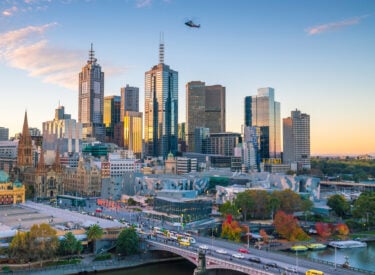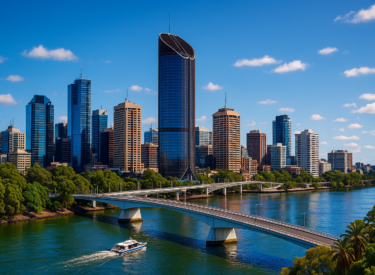
Key takeaways
Melbourne is on track to hit 9 million people by 2050, overtaking Sydney and becoming Australia’s largest city.
This growth will demand 1.6 million new homes, 1.5 million jobs, and infrastructure that can support 10 million daily trips—an 80% jump.
With all the noise—media hype, rate fears, political posturing—investors need clarity, not guesswork.
This is a once-in-a-generation opportunity, but only for those who think long term, act strategically, and don’t get distracted by short-term volatility.
Imagine a Melbourne the size of New York City.
Yes, really.
That’s the trajectory we’re on.
By 2050, Melbourne’s population is projected to swell to 9 million people, making it not just Australia’s biggest city by population, but potentially one of the most dynamic urban economies in the world.
This isn't some abstract urban planning fantasy—it’s based on official projections and a strategic blueprint - Plan Melbourne - backed by trends in migration, births, and economic transformation.
So what does this mean for our housing market—and for savvy investors?

Melbourne’s growth is unstoppable—and strategic
According to the original Plan Melbourne 2017–2050, the Victorian capital’s population was forecast to leap from 4.5 million (as at the time of the plan’s launch) to at least 8 million by 2050,
But more recent updates by Planning Victoria suggest we’re now hurtling toward the 9 million mark, overtaking Sydney much sooner than anticipated
And Victoria’s total population is set to top 10 million by 2051.
This isn’t just fast—it’s unprecedented for an Australian city.
The key drivers?
- A surge in overseas and interstate migration
- Natural population growth
- Melbourne’s magnetic liveability, job prospects, and international education appeal
But here’s the kicker: Melbourne will need 1.6 million new homes to accommodate this influx, along with 1.5 million new jobs.
The city's transport network will need to cater for around 10 million more trips a day – that’s an increase of more than 80%.
It will require vastly expanded infrastructure and a reimagined urban form to protect its liveability and sense of community.

Where will all these people live?
The Plan Melbourne strategy aims to contain urban sprawl by channelling growth into:
- Urban renewal precincts (think Fishermans Bend, Arden, E-Gate)
- Established inner and middle-ring suburbs (via rezoning and gentle densification)
- Strategically developed growth corridors on the city fringe (like the western growth area, north of Craigieburn, and southeast beyond Clyde)
What’s clear is that demand will surge for properties that are:
- Close to transport and employment hubs
- Within “20-minute neighbourhoods” where daily needs are met locally
- Located in walkable, well-serviced precincts
This means inner- and middle-ring suburbs are in the box seat, especially those with lifestyle appeal, gentrification potential, and new infrastructure investments.
The 20-minute neighbourhood
To be liveable, Melbourne will need to create a city of 20-minute neighbourhoods.
The concept of the 20-minute neighbourhood is simple.
It’s all about giving Melburnians the ability to live locally, meeting most of their everyday needs within a 20‑minute walk, cycle or local public transport trip from home.
Many of us will still need to travel outside our local area to go to work, but everyday needs, such as schools, shops, meeting places, open spaces, cafés, doctors, childcare, and access to public transport, will be only 20 minutes away.
Many of Melbourne’s established suburbs already have the ingredients for a 20-minute neighbourhood.
While Plan Melbourne aims to make the 20-minute neighbourhood a reality for every suburb, that will be exceedingly difficult in many of the new outer suburbs that just don’t have the necessary infrastructure or public transport.
Investment implications: a demand tsunami
From an investor’s perspective, Melbourne’s growth trajectory represents one of the biggest tailwinds in Australian real estate.
Here’s why:
- Housing undersupply is structural. Even now, building approvals are lagging behind population growth. With interest rates still relatively high, construction costs up, and builder insolvencies rife, we’re not building anywhere near what’s needed. This supply crunch will get worse before it gets better.
- Demand will remain resilient and rising, thanks to population growth, rental stress, and the appeal of owning in a rising market.
- Rents will keep rising. More people chasing fewer homes equals upward pressure on rents. Vacancy rates are already at near-historic lows.
- Capital growth will be location-specific. Properties in suburbs with well-developed infrastructure, job opportunities, lifestyle amenities, and limited supply will outperform.
The rise of the “missing middle” and medium density
One significant opportunity lies in medium-density housing, including townhouses, dual occupancies, and boutique apartment complexes in middle suburbs.
These areas are often underutilised and primed for redevelopment, especially given growing political pressure to rezone for density and deliver housing near jobs and transport.
Investors who get in ahead of this rezoning wave stand to benefit from significant value uplift.
Don’t forget: the Victorian government is already reviewing planning schemes to encourage more development within the existing urban footprint.
It’s not just a property story—it’s a liveability challenge
While this growth brings economic opportunities, it also presents social and environmental challenges:
- More extreme weather will demand climate-resilient buildings and green infrastructure
- Transport upgrades (Metro Tunnel, Suburban Rail Loop, new bus links) will be crucial to avoid congestion chaos
- There’s also a pressing need for more social and affordable housing, not just private dwellings
But here’s the silver lining: if the government gets it right and plans well, Melbourne won’t just be bigger—it will be better.
Plan Melbourne envisions a city of 20-minute neighbourhoods, job-rich suburbs, and sustainable design.
That’s a future worth investing in.
So, what should you do about it?
It’s one thing to read about Melbourne’s projected growth. It’s another to understand how to profit from it.
Yes, the numbers are big - 9 million people, 1.6 million homes, tens of billions in infrastructure.
But this isn’t just a government planning exercise.
This is a once-in-a-generation opportunity for investors who think long term, position themselves smartly, and make data-driven decisions.
But here’s the challenge...
There’s also a lot of noise - media hype, conflicting headlines, interest rate fears, and short-term uncertainty.
That’s exactly why now, more than ever, you need a clear strategy.
Not guesswork. Not speculation. A tailored roadmap based on your goals, risk profile, and time frame.
At Metropole, our Wealth Strategists help investors cut through the noise and make confident decisions.
We don’t just help you buy properties—we help you build wealth safely and strategically.
Let’s Chat About Your Future …If you’re ready to take advantage of Melbourne’s next chapter, why not start with a complimentary Wealth Discovery Session with one of our experienced Wealth Strategists?
You’ll get:
- A personalised review of your current position
- Actionable next steps based on your goals
- And no hard sell—just a genuine conversation to help you move forward.
Click here now to schedule your complimentary consultation with a Metropole Wealth Strategist
Because the best time to invest was yesterday.
The next best time?
Before Melbourne adds another 4.5 million people.














